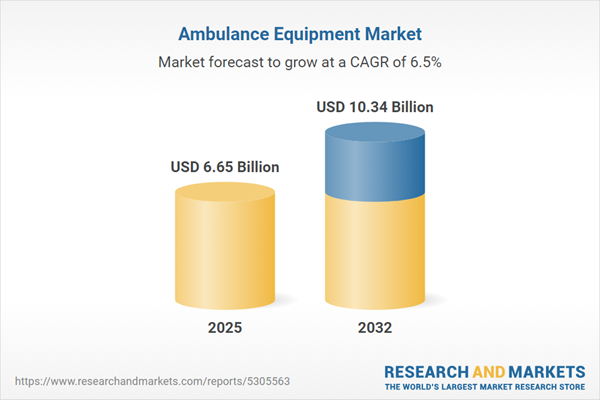Speak directly to the analyst to clarify any post sales queries you may have.
Senior leaders in emergency healthcare are navigating rising complexity, where technology, compliance, and reliability must converge amid rapid industry evolution. The ambulance equipment market demands integrated solutions that enhance operational agility and sustain organizational resilience.
Market Snapshot: Ambulance Equipment Market Size, Growth, and Dynamics
In 2024, the global ambulance equipment market reached USD 6.24 billion and is forecast to grow to USD 10.34 billion by 2032, marking a CAGR of 6.52%. This upward trend results from ongoing investment in emergency medical technologies, healthcare modernization, and intensified systems integration. As healthcare infrastructures evolve, organizations prioritize improved fleet reliability and rapid operational adaptation. Shifting regulatory frameworks and advancing digital solutions are steering more agile procurement, while smarter systems drive efficiencies for diverse care delivery models.
Scope & Segmentation: Ambulance Equipment Market Insights for Senior Leaders
Understanding the dimensions of the ambulance equipment market enables procurement and operations executives to optimize resources and refine strategy. This report offers insights designed for leaders addressing sector transformation and shifting care demands. Segmentation supports resource allocation, digital adoption, and responsive organizational design.
- Equipment Type: Field communications, advanced diagnostics, patient monitoring devices, and power systems strengthen clinical performance and workflow efficiency for emergency response teams.
- End User: Drivers for NGOs, public agencies, and private healthcare networks reflect diverse operational needs across urban, rural, and remote regions.
- Power Source: Battery and generator innovations enhance reliability and flexibility, supporting uninterrupted operation for various ambulance fleets.
- Ambulance Type: Distinct requirements for advanced and basic life support vehicles ensure equipment aligns with organizational clinical priorities and service environments.
- Regions and Sub-Regions: Analysis encompasses the Americas, EMEA, and Asia-Pacific, evaluating infrastructure maturity and regulatory conditions to inform resilient procurement decisions.
- Companies Analyzed: Supplier reviews focus on innovation, quality, and responsiveness, underpinning confident sourcing and robust asset management.
- Technological Trends: Modular diagnostics, IoMT integration, and energy management solutions drive sustainability and operational performance improvements.
Each segment enables organizations to strengthen the digital backbone of emergency operations, adapt to evolving patient needs, and optimize their supply chains on a regional and global scale.
Key Takeaways for Senior Leadership
- Live data from fleet management platforms enables executives to monitor operations in real time and support faster response to changing circumstances.
- Increased emphasis on modular and sustainable equipment aligns with compliance priorities and environmental objectives across care networks.
- Predictive maintenance strategies and real-time equipment monitoring help ensure high availability while minimizing unexpected interruptions during critical events.
- Strong supplier partnerships improve team training, facilitate consistent equipment readiness, and reinforce operational reliability.
- Flexible procurement supports rapid adaptation for both dense urban areas and humanitarian logistics challenges, advancing responsiveness across varying emergency settings.
- Collaborative supplier engagement assists organizations in navigating regulatory complexities and enhances agility in a changing market landscape.
Tariff Impact: Adjusting Sourcing Strategies in the US Ambulance Equipment Market
Recent tariffs on ambulance equipment and communications technology are prompting US healthcare providers to re-examine sourcing strategies. Organizations are increasingly exploring domestic and nearshore options to maintain cost efficiency and compliance, while safeguarding supply continuity. Flexible contracts and diversified suppliers mitigate regulatory disruptions, supporting uninterrupted operational capacity for frontline teams.
Methodology & Data Sources
Development of this market intelligence report included direct feedback from sector experts, ongoing review of regulatory developments, and independent peer validation. The methodology aligns with the priorities of procurement and sourcing leaders, ensuring practical, actionable guidance across the ambulance equipment value chain.
Why This Ambulance Equipment Market Report Matters
- Granular segmentation by region and end user helps supply chain teams proactively address risks and support business continuity.
- Regulatory trend analysis enables procurement decision-makers to enhance engagement and ensure operational stability.
- Close examination of technology and compliance supports stronger supplier relationships and shapes effective long-term planning for healthcare organizations.
Conclusion
Competitive use of technology, strong supplier collaboration, and adaptive regulatory management are central to resilient ambulance fleet operations. Strategic procurement and ongoing market vigilance position organizations to meet the evolving demands of emergency care.
Additional Product Information:
- Purchase of this report includes 1 year online access with quarterly updates.
- This report can be updated on request. Please contact our Customer Experience team using the Ask a Question widget on our website.
Table of Contents
3. Executive Summary
4. Market Overview
7. Cumulative Impact of Artificial Intelligence 2025
Companies Mentioned
The companies profiled in this Ambulance Equipment market report include:- Koninklijke Philips N.V.
- Stryker Corporation
- Asahi Kasei Corporation
- Zhangjiagang Medi Medical Equipment Co., ltd.
- Avante Health Solutions
- Hamilton Medical AG
- Medtronic PLC
- Drägerwerk AG & Co. KGaA
- Satpuda Engineering Pvt. Ltd.
- GPC Medical Ltd.
Table Information
| Report Attribute | Details |
|---|---|
| No. of Pages | 191 |
| Published | October 2025 |
| Forecast Period | 2025 - 2032 |
| Estimated Market Value ( USD | $ 6.65 Billion |
| Forecasted Market Value ( USD | $ 10.34 Billion |
| Compound Annual Growth Rate | 6.5% |
| Regions Covered | Global |
| No. of Companies Mentioned | 11 |









